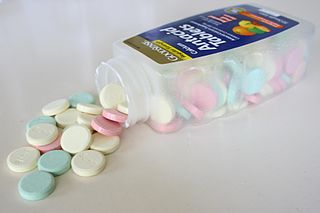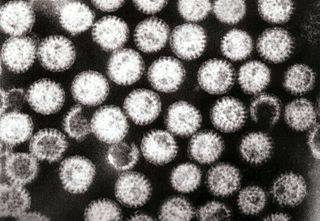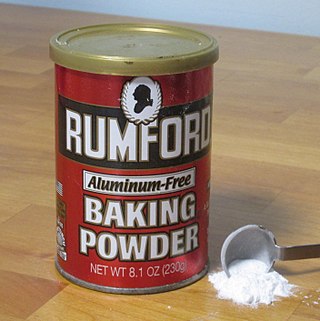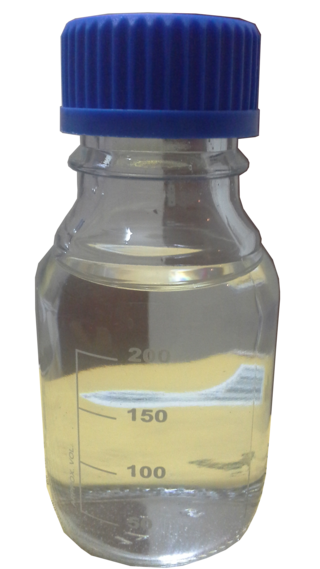
Eno is an over-the-counter antacid brand produced by Haleon. Its main ingredients are sodium carbonate, sodium bicarbonate and citric acid. [1] [2] [3]

Eno is an over-the-counter antacid brand produced by Haleon. Its main ingredients are sodium carbonate, sodium bicarbonate and citric acid. [1] [2] [3]
Eno was first marketed by James Crossley Eno (1827–1915). [4] Legend has it that his idea for the product arose while he was working at the pharmacy of an infirmary in Newcastle, Britain, with Dennis Embleton; Embleton often prescribed an effervescent drink made by mixing sodium bicarbonate and citric acid in water, and Eno adopted this beverage. [5] In reality, Eno opened a pharmacy where he made the mixture in 1852, a year before Embleton came to work at the infirmary, and such fruit salt mixtures were common at the time. [5]
Eno gave away his branded mixture to sea captains at the port, and in this way Eno's became a brand known around the world. By 1865 he had to move to a bigger facility, and he formally founded the company Eno's "Fruit Salt" Works in 1868. [5] [6] [7] : 253 In 1878 Eno moved the business to Hatcham where the factory employed 50 people by 1884. [8]
Eno was advertised heavily, as all patent medicines were at that time. [5] In 1883 it was advertised as a cure for cholera [9] and in 1892 for "keeping blood pure and free from disease", prevention of diarrhea, and many other conditions. [10] By 1928 the company had factories in England, Canada, France, Germany, Spain, and the US; that year the company was acquired by International Proprietaries, a company that had been established by Canadian businessman Harold F. Ritchie. [7] : 253 International Proprietaries was eventually renamed Eno, and in 1938 the business was bought by Beecham [7] : 253 for its products as well as its international marketing force. [11] As the pharmaceutical industry transitioned from selling cure-all patent medicines to selling drugs in the 1950s, Eno was one of a handful of products that were retained in the industry. [12] : 154

An antacid is a substance which neutralizes stomach acidity and is used to relieve heartburn, indigestion, or an upset stomach. Some antacids have been used in the treatment of constipation and diarrhea. Marketed antacids contain salts of aluminum, calcium, magnesium, or sodium. Some preparations contain a combination of two salts, such as magnesium carbonate and aluminum hydroxide.

Diarrhea, also spelled diarrhoea or diarrhœa, is the condition of having at least three loose, liquid, or watery bowel movements in a day. It often lasts for a few days and can result in dehydration due to fluid loss. Signs of dehydration often begin with loss of the normal stretchiness of the skin and irritable behaviour. This can progress to decreased urination, loss of skin color, a fast heart rate, and a decrease in responsiveness as it becomes more severe. Loose but non-watery stools in babies who are exclusively breastfed, however, are normal.

Citric acid is an organic compound with the chemical formula HOC(CO2H)(CH2CO2H)2. It is a colorless weak organic acid. It occurs naturally in citrus fruits. In biochemistry, it is an intermediate in the citric acid cycle, which occurs in the metabolism of all aerobic organisms.

Sodium bicarbonate (IUPAC name: sodium hydrogencarbonate), commonly known as baking soda or bicarbonate of soda, is a chemical compound with the formula NaHCO3. It is a salt composed of a sodium cation (Na+) and a bicarbonate anion (HCO3−). Sodium bicarbonate is a white solid that is crystalline but often appears as a fine powder. It has a slightly salty, alkaline taste resembling that of washing soda (sodium carbonate). The natural mineral form is nahcolite, although it is more commonly found as a component of the mineral trona.

Sodium carbonate is the inorganic compound with the formula Na2CO3 and its various hydrates. All forms are white, odourless, water-soluble salts that yield alkaline solutions in water. Historically, it was extracted from the ashes of plants grown in sodium-rich soils, and because the ashes of these sodium-rich plants were noticeably different from ashes of wood, sodium carbonate became known as "soda ash". It is produced in large quantities from sodium chloride and limestone by the Solvay process, as well as by carbonating sodium hydroxide which is made using the Chlor-alkali process.

Baking powder is a dry chemical leavening agent, a mixture of a carbonate or bicarbonate and a weak acid. The base and acid are prevented from reacting prematurely by the inclusion of a buffer such as cornstarch. Baking powder is used to increase the volume and lighten the texture of baked goods. It works by releasing carbon dioxide gas into a batter or dough through an acid–base reaction, causing bubbles in the wet mixture to expand and thus leavening the mixture. The first single-acting baking powder was developed by food manufacturer Alfred Bird in England in 1843. The first double-acting baking powder, which releases some carbon dioxide when dampened and later releases more of the gas when heated by baking, was developed by Eben Norton Horsford in the U.S. in the 1860s.

Potassium bicarbonate (IUPAC name: potassium hydrogencarbonate, also known as potassium acid carbonate) is the inorganic compound with the chemical formula KHCO3. It is a white solid.

Carbonated water is water containing dissolved carbon dioxide gas, either artificially injected under pressure or occurring due to natural geological processes. Carbonation causes small bubbles to form, giving the water an effervescent quality. Common forms include sparkling natural mineral water, club soda, and commercially produced sparkling water.

A lime is a citrus fruit, which is typically round, green in color, 3–6 centimetres (1.2–2.4 in) in diameter, and contains acidic juice vesicles.
The Leblanc process was an early industrial process for making soda ash used throughout the 19th century, named after its inventor, Nicolas Leblanc. It involved two stages: making sodium sulfate from sodium chloride, followed by reacting the sodium sulfate with coal and calcium carbonate to make sodium carbonate. The process gradually became obsolete after the development of the Solvay process.

Oral rehydration therapy (ORT) is a type of fluid replacement used to prevent and treat dehydration, especially due to diarrhea. It involves drinking water with modest amounts of sugar and salts, specifically sodium and potassium. Oral rehydration therapy can also be given by a nasogastric tube. Therapy can include the use of zinc supplements to reduce the duration of diarrhea in infants and children under the age of 5. Use of oral rehydration therapy has been estimated to decrease the risk of death from diarrhea by up to 93%.

Fruit Roll-Ups is a brand of snack that debuted in grocery stores across America in 1983. It is a flat, corn syrup-based, fruit-flavored snack rolled into a tube, spread on a backing sheet of cellophane to prevent the product from sticking to itself.

Metabolic alkalosis is an acid-base disorder in which the pH of tissue is elevated beyond the normal range (7.35–7.45). This is the result of decreased hydrogen ion concentration, leading to increased bicarbonate, or alternatively a direct result of increased bicarbonate concentrations. The condition typically cannot last long if the kidneys are functioning properly.

Monosodium citrate, more correctly, sodium dihydrogen citrate (Latin: natrium citricum acidulatum), is an acid salt of citric acid. Disodium citrate and trisodium citrate are also known. It can be prepared by partial neutralisation of citric acid with an aqueous solution of sodium bicarbonate or carbonate. It has a slightly acidic taste.
Sodium citrate may refer to any of the sodium salts of citric acid :

Effervescent or carbon tablets are tablets which are designed to dissolve in water and release carbon dioxide. The carbon dioxide is generated by a reaction of a compound containing bicarbonate, such as sodium bicarbonate or magnesium bicarbonate, with an acid such as citric acid or tartaric acid. Both compounds are present in the tablet in powder form and start reacting as soon as they dissolve in water.

Andrews Liver Salts was a laxative and antacid for mild stomach complaints. It was sold as a powder which is added to water and mixed, creating effervescence, before being swallowed. The powder contains sugar; an antacid, sodium bicarbonate ; citric acid ; and a laxative, magnesium sulphate. The product is similar to Eno's salts and Kruschen salts, and a mild form of Epsom salts. The term "liver salts" or "health salts" is typically used for a laxative.
James Crossley Eno was a British pharmacist known for compounding and selling a brand of fruit salt that is still popular today as an antacid.
A fruit salt or fruit salts is an effervescent compound made up of organic acids such as citric acid or tartaric acid and salts such as sodium bicarbonate, sodium carbonate, or sodium bitartrate in combination with added flavoring and sugar. Historically, fruit salts were sold for a wide range of ailments, and today they are used primarily as antacids.

Antikamnia Chemical Company (1890–1930), named after its patent medicine Antikamnia, was an American pharmaceutical company based in St. Louis that manufactured supposed cures for pains with the main ingredient being acetanilid, which was known to be toxic in high doses or in sensitive individuals. They produced a range of products with mixtures of therapeutic chemicals including both quinine and heroin. Unlike quack cures of the time, they contained potent chemicals but these were not carefully tested and were considered as nostrums by many physicians of the time. The company however made huge profits through clever advertising and marketing of the product targeting physicians, using physician testimonials and finding loopholes in the Pure Food and Drug Act of 1906.
Last updated 1 January 2016